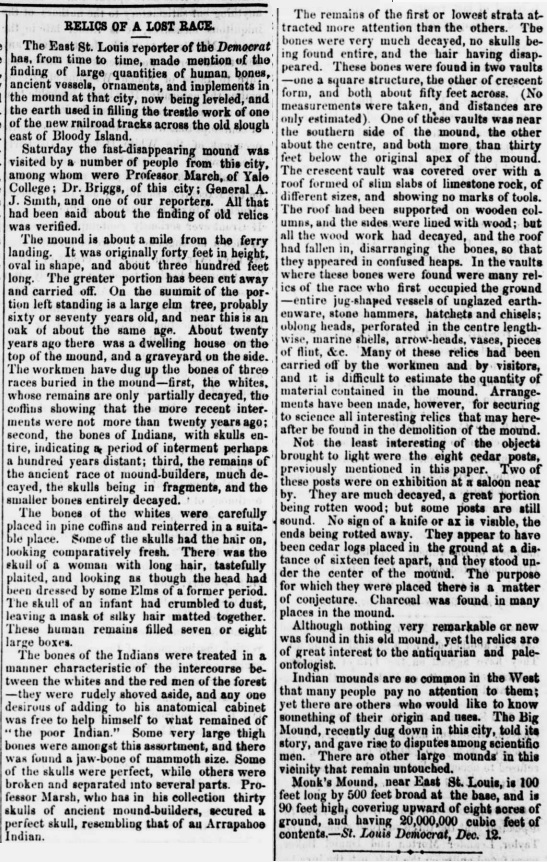Clair County – Very Large Thigh Bones
RELICS OF A LOST RACE.
The East St. Louis Reporter of the Democrat has, from time to time, made mention of the finding of large quantities of human bones, ancient vessels, ornaments, and implements in the mound at that city, now being leveled, and the earth used in filling the trestlework of one of the new railroad tracks across the old slough east of Bloody Island.
Saturday, the fast-disappearing mound was visited by a number of people from this city, among whom were Professor March, of Yale College; Dr. Briggs, of this city; General A. J. Smith, and one of our reporters. All that had been said about the finding of old relics was verified.
The mound is about a mile from the ferry landing. It was originally forty feet in height, oval in shape, and about three hundred feet long. The greater portion has been cut away and carried off. On the summit of the portion left standing is a large elm tree, probably sixty or seventy years old, and near this is an oak of about the same age. About twenty years ago there was a dwelling house on the top of the mound, and a graveyard on the side.
The workmen have dug up the bones of three races buried in the mound — first, the Whites, whose remains are only partially decayed, the coffins showing that the more recent interments were not more than twenty years ago; second, the bones of Indians, with skulls entire, indicating a period of interment perhaps a hundred years distant; third, the remains of the ancient race of mound-builders, much decayed, the skulls being in fragments, and the smaller bones entirely decayed.
The bones of the Whites were carefully placed in pine coffins and reinterred in a suitable place. Some of the skulls had hair on, looking comparatively fresh. There was the skull of a woman with long hair, tastefully plaited, and looking as though the head had been dressed by some Elm of a former period. The skull of an infant had crumbled to dust, leaving a mask of silky hair matted together. These human remains filled seven or eight large boxes.
The bones of the Indians were treated in a manner characteristic of the intercourse between the Whites and the Red men of the forest—they were rudely shoved aside, and anyone desirous of adding to his anatomical cabinet was free to help himself to what remained of “the poor Indian.” Some very large thigh bones were amongst this assortment, and there was found a jawbone of mammoth size. Some of the skulls were perfect, while others were broken and separated into several parts. Professor Marsh, who has in his collection thirty skulls of ancient mound-builders, secured a perfect skull, resembling that of an Arrapahoe Indian.
The remains of the first or lowest strata attracted more attention than the others. The bones were very much decayed, no skulls being found entire, and the hair having disappeared. These bones were found in two vaults—one a square structure, the other of crescent form, and both about fifty feet across (No measurements were taken, and distances are only estimated). One of these vaults was near the southern side of the mound, the other about the center, and both more than thirty feet below the original apex of the mound.
The crescent vault was covered over with a roof formed of slim slabs of limestone rock, of different sizes, and showing no marks of tools. The roof had been supported on wooden columns, and the sides were lined with wood; but all the woodwork had decayed, and the roof had fallen in, disarranging the bones, so that they appeared in confused heaps. In the vaults where these bones were found were many relics of the
Race who first occupied the ground—entire jug-shaped vessels of unglazed earthenware, stone hammers, hatchets and chisels; oblong heads, perforated in the centre lengthwise, marine shells, arrowheads, vases, pieces of flint, etc. Many of these relics had been carried off by the workmen and by visitors, and it is difficult to estimate the quantity of material contained in the mound. Arrangements have been made, however, for securing to science all interesting relics that may hereafter be found in the demolition of the mound. Not the least interesting of the objects brought to light were the eight cedar posts, previously mentioned in this paper. Two of these posts were on exhibition at a saloon nearby. They are much decayed, a great portion being rotten wood, but some posts are still sound. No sign of a knife or ax is visible, the ends being rotted away. They appear to have been cedar logs placed in the ground at a distance of sixteen feet apart, and they stood under the center of the mound. The purpose for which they were placed there is a matter of conjecture. Charcoal was found in many places in the mound.
Although nothing very remarkable or new was found in this old mound, yet the relics are of great interest to the antiquarian and paleontologist. Indian mounds are so common in the West that many people pay no attention to them; yet there are others who would like to know something of their origin and uses. The Big Mound, recently dug down in this city, told its story, and gave rise to disputes among scientific men. There are other large mounds in this vicinity that remain untouched. Monk’s Mound, near East St. Louis, is 100 feet long by 500 feet broad at the base, and is 90 feet high, covering upward of eight acres of ground, and having 20,000,000 cubic feet of contents.—St. Louis Democrat, Dec. 12.
The Idaho world. [volume], January 26, 1871, Image 1
The Idaho world. [volume], January 26, 1871, Image 1
